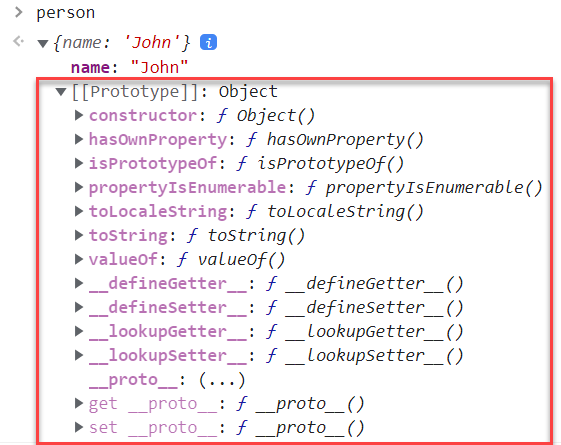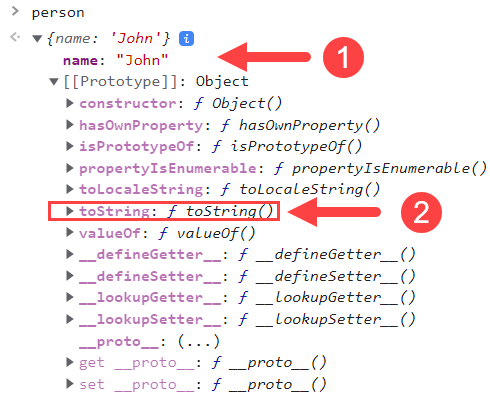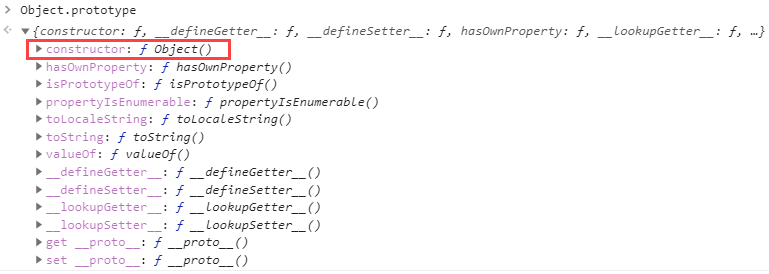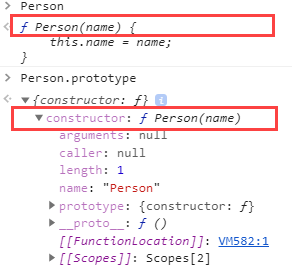Summary: in this tutorial, you’ll learn about the JavaScript prototype and how it works under the hood.
Introduction to JavaScript prototype
In JavaScript, objects can inherit features from one another via prototypes. Every object has its own property called a prototype.
Because the prototype itself is also another object, the prototype has its own prototype. This creates a something called prototype chain. The prototype chain ends when a prototype has null for its own prototype.
Suppose you have an object person with a property called name:
let person = {'name' : 'John'}Code language: JavaScript (javascript)When examining the person object in the console, you’ll find that the person object has a property called prototype denoted by the [[Prototype]]:

The prototype itself is an object with its own properties:

When you access a property of an object, if the object has that property, it’ll return the property value. The following example accesses the name property of the person object:

It returns the value of the name property as expected.
However, if you access a property that doesn’t exist in an object, the JavaScript engine will search in the prototype of the object.
If the JavaScript engine cannot find the property in the object’s prototype, it’ll search in the prototype’s prototype until it finds the property or reaches the end of the prototype chain.
For example, you can call the toString() method of the person object like this:

The toString() method returns the string representation of the person object. By default, it’s [object Object] which is not obvious.
Note that when a function is a value of an object’s property, it’s called a method. Therefore, a method is a property with value as a function.
In this example, when we call the toString() method on the person object, the JavaScript engine finds it in the person object.
Because the person object doesn’t have the toString() method, it’ll search for the toString() method in the person’s prototype object.
Since the person’s prototype has the toString() method, JavaScript calls the toString() of the person’s prototype object.

JavaScript prototype illustration
JavaScript has the built-in Object() function. The typeof operator returns 'function' if you pass the Object function to it. For example:
typeof(Object)Code language: JavaScript (javascript)Output:
'function'Code language: JavaScript (javascript)Please note that Object() is a function, not an object. It’s confusing if this is the first time you’ve learned about the JavaScript prototype.
Also, JavaScript provides an anonymous object that can be referenced via the prototype property of the Object() function:
console.log(Object.prototype);Code language: JavaScript (javascript)The Object.prototype object has some useful properties and methods such as toString() and valueOf().
The Object.prototype also has an important property called constructor that references the Object() function.
The following statement confirms that the Object.prototype.constructor property references the Object function:
console.log(Object.prototype.constructor === Object); // trueCode language: JavaScript (javascript)Suppose a circle represents a function and a square represents an object. The following picture illustrates the relationship between the Object() function and the Object.prototype object:
First, define a constructor function called Person as follows:
function Person(name) {
this.name = name;
}Code language: JavaScript (javascript)In this example, the Person() function accepts a name argument and assigns it to the name property of the this object.
Behind the scenes, JavaScript creates a new function Person() and an anonymous object:
Like the Object() function, the Person() function has a property called prototype that references an anonymous object. The anonymous object has the constructor property that references the Person() function.
The following shows the Person() function and the anonymous object referenced by the Person.prototype:
console.log(Person);
console.log(Person.prototype);Code language: CSS (css)In addition, JavaScript links the Person.prototype object to the Object.prototype object via the [[Prototype]], which is known as a prototype linkage.
The prototype linkage is denoted by [[Prototype]] in the following figure:
Defining methods in the JavaScript prototype object
The following defines a new method called greet() in the Person.prototype object:
Person.prototype.greet = function() {
return "Hi, I'm " + this.name + "!";
}Code language: JavaScript (javascript)In this case, the JavaScript engine adds the greet() method to the Person.prototype object:
The following creates a new instance of the Person :
let p1 = new Person('John');Code language: JavaScript (javascript)Internally, the JavaScript engine creates a new object named p1 and links the p1 object to the Person.prototype object via the prototype linkage:
The link between p1, Person.prototype, and Object.protoype is called a prototype chain.
The following calls the greet() method on the p1 object:
let greeting = p1.greet();
console.log(greeting);Code language: JavaScript (javascript)Because p1 doesn’t have the greet() method, JavaScript follows the prototype linkage and finds it on the Person.prototype object.
Since JavaScript can find the greet() method on the Person.prototype object, it executes the greet() method and returns the result:
The following calls the toString() method on the p1 object:
let s = p1.toString();
console.log(s);Code language: JavaScript (javascript)In this case, the JavaScript engine follows the prototype chain to look up the toString() method in the Person.prototype.
Because the Person.prototype doesn’t have the toString() method, the JavaScript engine goes up to the prototype chain and searches for the toString() method in the Object.prototype object.
Since JavaScript can find the toString() method in the Object.prototype, it executes the toString() method.
If you call a method that doesn’t exist on the Person.prototype and Object.prototype object, the JavaScript engine will follow the prototype chain and throw an error if it cannot find the method. For example:
p1.fly();
Code language: CSS (css)Because the fly() method doesn’t exist on any object in the prototype chain, the JavaScript engine issues the following error:
TypeError: p1.fly is not a functionCode language: JavaScript (javascript)The following creates another instance of the Person whose name property is 'Jane':
let p2 = new Person('Jane');Code language: JavaScript (javascript)The p2 object has the same properties and methods as the p1 object.
In conclusion, when you define a method on the prototype object, this method is shared by all instances.
Defining methods in an individual object
The following defines the draw() method on the p2 object.
p2.draw = function () {
return "I can draw.";
};
Code language: JavaScript (javascript)The JavaScript engine adds the draw() method to the p2 object, not the Person.prototype object:
It means that you can call the draw() method on the p2 object:
p2.draw();Code language: CSS (css)But you cannot call the draw() method on the p1 object:
p1.draw()Code language: CSS (css)Error:
TypeError: p1.draw is not a functionCode language: JavaScript (javascript)When you define a method in an object, the method is only available to that object. It cannot be shared with other objects by default.
Getting prototype linkage
The __proto__ is pronounced as dunder proto. The __proto__ is an accessor property of the Object.prototype object. It exposes the internal prototype linkage ( [[Prototype]]) of an object through which it is accessed.
The __proto__ has been standardized in ES6 to ensure compatibility with web browsers. However, it may be deprecated in favor of Object.getPrototypeOf() in the future. Therefore, you should never use the __proto__ in your production code.
The p1.__proto__ exposes the [[Prototype]] that references the Person.prototype object.
Similarly, p2.__proto__ also references the same object as p1.__proto__:
console.log(p1.__proto__ === Person.prototype); // true
console.log(p1.__proto__ === p2.__proto__); // trueCode language: JavaScript (javascript)As mentioned earlier, you should use the Object.getPrototypeOf() method instead of the __proto__. The Object.getPrototypeOf() method returns the prototype of a specified object.
console.log(p1.__proto__ === Object.getPrototypeOf(p1)); // trueCode language: JavaScript (javascript)Another popular way to get the prototype linkage is when the Object.getPrototypeOf() method is not available via the constructor property as follows:
p1.constructor.prototypeCode language: CSS (css)The p1.constructor returns Person, therefore, p1.constructor.prototype returns the prototype object.
Shadowing
See the following method call:
console.log(p1.greet());Code language: CSS (css)The p1 object doesn’t have the greet() method defined, therefore JavaScript goes up to the prototype chain to find it. In this case, it can find the method in the Person.prototype object.
Let’s add a new method to the object p1 with the same name as the method in the Person.prototype object:
p1.greet = function() {
console.log('Hello');
}Code language: JavaScript (javascript)And call the greet() method:
console.log(p1.greet());Code language: CSS (css)Because the p1 object has the greet() method, JavaScript just executes it immediately without looking it up in the prototype chain.
This is an example of shadowing. The greet() method of the p1 object shadows the greet() method of the prototype object which the p1 object references.
Summary
- The
Object()function has a property calledprototypethat references aObject.prototypeobject. - The
Object.prototypeobject has all properties and methods which are available in all objects such astoString()andvalueOf(). - The
Object.prototypeobject has theconstructorproperty that references theObjectfunction. - Every function has a
prototypeobject. This prototype object references theObject.prototypeobject via[[prototype]]linkage or__proto__property. - The prototype chain allows one object to use the methods and properties of its
prototypeobjects via the[[prototype]]linkages. - The
Object.getPrototypeOf()method returns the prototype object of a given object. Do use theObject.getPrototypeOf()method instead of__proto__.

